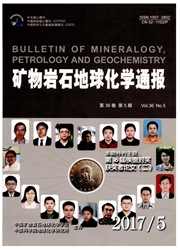

 中文摘要:
中文摘要:
大别山中生代侵入岩氧同位素结果表明它们受到了岩浆期后亚固相水-岩相互作用的扰动。为了确定水-岩交换过程中的有关参数,本文利用交换反应动力学模型分别对大别山中生代主簿源、天柱山和团岭花岗岩以及沙村和椒子岩辉长岩矿物-水氧同位素交换反应动力学进行了定量计算,并估计了水-岩反应有效时限、流体流动速率和水/岩值。多维矿物相-水氧同位素交换反应动力学定量模拟结果表明,大别山主簿源、天柱山和团岭花岗岩岩浆期后亚固相水-岩反应的有效时限约为0.3~3Ma,流体流动速率约为1×10^-15~3×10^-14mol/s,水/岩值为0.27~0.78;沙村和椒子岩辉长岩岩浆期后亚固相水-岩反应的有效时限约为0.02~0.4Ma,流体流动速率约为1.6×10^-14~4.8×10^-13mol/s,水/岩值为0.11~O.33。
 英文摘要:
英文摘要:
The results of oxygen isotope for Mesozoic igneous rocks from the Dabie orogen indicate that they have suffered post-magmatic water-rock interaction. In order to determine the parameters related to water-rock interaction, quantitative simulation was carried out by using the kinetic model of oxygen isotope exchange between multiminerals and water for Mesozoic granitoids at Zhubuyuan, Tianzhushan and Tuanling as well as mafic-ultramafic rocks at Shacun and Jiaoziyan in the Dabie orogen. The results suggest that the timescale of water-rock interaction is about 0.3 to 3 Ma, the flow rate of fluid is about 1 × 10^-15 to 3 × 10^-14 mol/s , and ratio of water to rock is about 0.27 to 0.78 for granitoids; the timescale of water-rock interaction is about 0.02 to 0. 4 Ma, the flow rate of fluid is about 1.6 × 10^-14 to 4.8× 10^-13 mol/s , and ratio of water to rock is about 0.11 to 0.33 for gabbros.
 同期刊论文项目
同期刊论文项目
 同项目期刊论文
同项目期刊论文
 期刊信息
期刊信息
